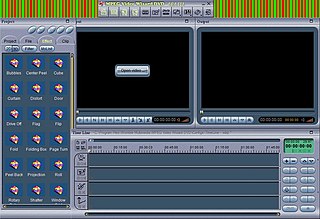Related Research Articles

DVD-Audio is a digital format for delivering high-fidelity audio content on a DVD. DVD-Audio uses most of the storage on the disc for high-quality audio and is not intended to be a video delivery format.

VideoLAN is a non-profit organization which develops software for playing video and other media formats. It originally developed two programs for media streaming, VideoLAN Client (VLC) and VideoLAN Server (VLS), but most of the features of VLS have been incorporated into VLC, with the result renamed VLC media player.

VLC media player is a free and open-source, portable, cross-platform media player software and streaming media server developed by the VideoLAN project. VLC is available for desktop operating systems and mobile platforms, such as Android, iOS and iPadOS. VLC is also available on digital distribution platforms such as Apple's App Store, Google Play, and Microsoft Store.
Ripping is extracting all or parts of digital content from a container. Originally, it meant to rip music out of Commodore 64 games. Later, the term was used to mean to extract WAV or MP3 format files from digital audio CDs, but got applied as well to extract the contents of any media, including DVD and Blu-ray discs, and video game sprites.

DVD Shrink is a freeware DVD transcoder program for Microsoft Windows that uses a DVD ripper to back up DVD video. The final versions are 3.2.0.15 (English) and 3.2.0.16 (German); all other versions, such as DVD Shrink 2010, are illegitimate. DVD Shrink's purpose is, as its name implies, to reduce the amount of data stored on a DVD with minimal loss of quality, although some loss of quality is inevitable. It creates a copy of a DVD, during which the DVD region code is removed, and copy protection may also be circumvented. A stamped DVD may require more space than is available on a writeable DVD, unless shrunk. Many commercially released video DVDs are dual layer ; DVD Shrink can make a shrunk copy which will fit on a single-layer writeable DVD, processing the video with some loss of quality and allowing the user to discard unwanted content such as foreign-language soundtracks.
Nero Digital is a brand name applied to a suite of MPEG-4-compatible video and audio compression codecs developed by Nero AG of Germany and Ateme of France. The audio codecs are integrated into the Nero Digital Audio+ audio encoding tool for Microsoft Windows, and the audio & video codecs are integrated into Nero's Recode DVD ripping software.
The following comparison of video players compares general and technical information for notable software media player programs.
TMPGEnc or TSUNAMI MPEG Encoder is a video transcoder software application primarily for encoding video files to VCD and SVCD-compliant MPEG video formats and was developed by Hiroyuki Hori and Pegasys Inc. TMPGEnc can also refer to the family of software video encoders created after the success of the original TMPGEnc encoder. These include: TMPGEnc Plus, TMPGEnc Free Version, TMPGenc Video Mastering Works, TMPGEnc Authoring Works, TMPGEnc MovieStyle and TMPGEnc MPEG Editor. TMPGEnc products run on Microsoft Windows.
cDVD discs, also known as mini-DVD discs, are regular data CDs that contain MPEG-2 or MPEG-1 video structured in accordance with the DVD-Video specifications.
These tables compare features of multimedia container formats, most often used for storing or streaming digital video or digital audio content. To see which multimedia players support which container format, look at comparison of media players.
Flash Video is a container file format used to deliver digital video content over the Internet using Adobe Flash Player version 6 and newer. Flash Video content may also be embedded within SWF files. There are two different Flash Video file formats: FLV and F4V. The audio and video data within FLV files are encoded in the same way as SWF files. The F4V file format is based on the ISO base media file format, starting with Flash Player 9 update 3. Both formats are supported in Adobe Flash Player and developed by Adobe Systems. FLV was originally developed by Macromedia. In the early 2000s, Flash Video was the de facto standard for web-based streaming video. Users include Hulu, VEVO, Yahoo! Video, metacafe, Reuters.com, and many other news providers.
K-Multimedia Player is an Adware-supported media player for Windows and iOS that can play most current audio and video formats, including VCD, HDML, DVD, AVI, MKV, Ogg, OGM, 3GP, MPEG-1/2/4, AAC, WMA 7, 8, WMV, RealMedia, FLV and QuickTime. KMPlayer shows many advertisements, including in the homepage, side panels, options panel, and as pop-up ads.
Program stream is a container format for multiplexing digital audio, video and more. The PS format is specified in MPEG-1 Part 1 and MPEG-2 Part 1, Systems. The MPEG-2 Program Stream is analogous and similar to ISO/IEC 11172 Systems layer and it is forward compatible.
The DVD-VR standard defines a logical format for video recording on DVD-R, DVD-RW, and DVD-RAM style media, including the dual layer versions of these media. As opposed to media recorded with the DVD+VR recording standard, the resulting media are not DVD-Video compliant, and do not play back in some DVD-Video players. Most DVD video recorders in the market that support DVD-R, DVD-RW, or DVD-RAM media record to these media in DVD-VR mode, as well as in a DVD-Video compliant mode. It is possible to use the DVD-VR format with DVD+R and DVD+RW media, but no examples are known other than some PC based recording utilities.

The Advanced Access Content System (AACS) is a standard for content distribution and digital rights management, intended to restrict access to and copying of the post-DVD generation of optical discs. The specification was publicly released in April 2005. The standard has been adopted as the access restriction scheme for HD DVD and Blu-ray Disc (BD). It is developed by AACS Licensing Administrator, LLC, a consortium that includes Disney, Intel, Microsoft, Panasonic, Warner Bros., IBM, Toshiba and Sony. AACS has been operating under an "interim agreement" since the final specification has not yet been finalized.
Enhanced Video Object, also known as Enhanced VOB, EVOB or EVO, is a container format for HD DVD video media. It contains the actual digital video, digital audio, subtitle and DVD menu contents in stream form. It is an extension to VOB. It can contain video encoded in H.264/MPEG-4 AVC, VC-1, or H.262/MPEG-2 Part 2 and audio encoded in AC-3, E-AC-3, Dolby TrueHD, DTS, DTS-HD, PCM, and MPEG-2 Part 3.
.m2ts is a filename extension used for the Blu-ray disc Audio-Video (BDAV) MPEG-2 Transport Stream (M2TS) container file format. It is used for multiplexing audio, video and other streams, such as subtitles. It is based on the MPEG-2 transport stream container. This container format is commonly used for high definition video on Blu-ray Disc and AVCHD.
The Content Scramble System (CSS) is a digital rights management (DRM) and encryption system employed on many commercially produced DVD-Video discs. CSS utilizes a proprietary 40-bit stream cipher algorithm. The system was introduced around 1996 and was first compromised in 1999.

DVD-Video is a consumer video format used to store digital video on DVD discs. DVD-Video was the dominant consumer home video format in Asia, North America, Europe, and Australia in the 2000s until it was supplanted by the high-definition Blu-ray Disc. Discs using the DVD-Video specification require a DVD drive and an MPEG-2 decoder. Commercial DVD movies are encoded using a combination of MPEG-2 compressed video and audio of varying formats. Typically, the data rate for DVD movies ranges from 3 to 9.5 Mbit/s, and the bit rate is usually adaptive. DVD-Video was first available in Japan on November 1, 1996, followed by a release on March 24, 1997 in the United States—to line up with the 69th Academy Awards that same day.

MPEG Video Wizard DVD, also known as MVW-DVD, is a non-linear video editing software developed by Womble Multimedia, Inc.. It allows users to edit video content, create DVDs with menus and then burn them without the need for any additional software.
References
- ↑ "VOB File Format". WhatIs.com. TechTarget. Retrieved 18 April 2012.
- ↑ ".VOB File". FileExt. UniBlue. Retrieved 18 April 2012.
- ↑ DVD FLLC (2009-02) DVD Book Construction - list of all available DVD Books, Retrieved on 2009-07-24
- ↑ DVD FLLC DVD Format Book - History of Supplements for DVD Books, Retrieved on 2009-07-24
- ↑ ".VOB File Extension". FileInfo.com. Retrieved 18 April 2012.
- 1 2 3 "What is a VOB file". MPUCoder. SoundWare Associates. Retrieved 18 April 2012.
- 1 2 "DVD - MPeg (sic.) differences". DVD Resources for Open Source Development. SourceForge . Retrieved 28 April 2012.
- ↑ "Is it easy to understand DVD format?". Archived from the original on 2001-10-24. Retrieved 2011-02-26.
- ↑ MPEG.org (July 21, 1996) DVD Technical Notes - Video Data Specifications, Retrieved on 2009-07-25
- ↑ Videohelp.com What is DVD? Technical Info for DVD-Video, Retrieved on 2009-07-28
- ↑ Doom9.org doom9.org What's on a DVD?, Retrieved on 2009-07-26
- ↑ AfterDawn.com (2007-07-31) How to play VOB / IFO / BUP files, Retrieved on 2009-07-26
- ↑ DVD Demystified (July 13, 2009) What are the copy protection issues?, Retrieved on 2009-07-28
- ↑ DVD Demystified (July 13, 2009) DVD Frequently Asked Questions (and Answers) - Why can't I play movies copied to my hard drive?, Retrieved on 2009-07-28
- 1 2 What are the copy protection schemes used in DVD ? What is CSS ?, Retrieved on 2009-07-28
- 1 2 DVD Demystified (July 13, 2009) What are .IFO, .VOB, .AOB, and .VRO files? How can I play them?, Retrieved on 2009-07-28
- ↑ Doom9's forum (2002-2005) DVD-RAM *.VRO File Conversion, Retrieved on 2009-07-28
- ↑ DVD-VR Application format notes, Retrieved on 2009-07-28